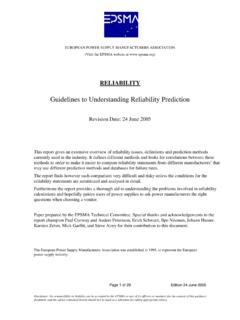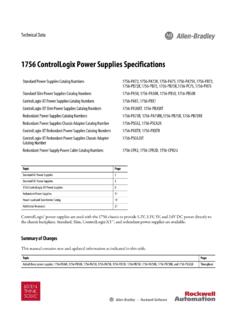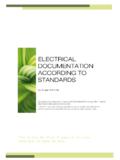Transcription of Guidelines to the standard EN 61000-3-2 - EPSMA
1 Page 1 Edition Nov 2010 Disclaimer: No responsibility or liability can be accepted by the EPSMA or any of its officers or members for the content of this guidance document, which does not necessarily guarantee compliance with the requirements of the legislation. Parties will need to satisfy themselves as to the steps to be taken to ensure compliance with legislative requirements and the advice contained herein should not be used as a substitute for taking appropriate advice. EUROPEAN POWER SUPPLY MANUFACTURERS ASSOCIATION (Visit the EPSMA website at ) Harmonic Current Emissions Guidelines to the standard EN 61000 -3-2 Revision Date: 2010-11-8 Paper prepared by the EPSMA Technical Committee. Special thanks and acknowledgements for this revision, to Matthias Emerson (Delta Energy Systems), for his contribution to this document. Supported by Bureau Veritas E&E Product Services GmbH, T rkheim, Germany The European Power Supply Manufacturers Association was established in 1995, to represent the European power supply industry.
2 Page 2 Edition Nov 2010 Disclaimer: No responsibility or liability can be accepted by the EPSMA or any of its officers or members for the content of this guidance document, which does not necessarily guarantee compliance with the requirements of the legislation. Parties will need to satisfy themselves as to the steps to be taken to ensure compliance with legislative requirements and the advice contained herein should not be used as a substitute for taking appropriate advice. page 1. Introduction 3 2. Summary 3 3. Scope 3 Application 3 Transitional periods 4 Differences between the standards EN 61000 -3-2:2006 and older versions 4 4. Application Guidelines 4 5. Classification and limits 6 6. Harmonic line current reduction techniques 8 Comparison without / with harmonic line current reduction 8 Advantages / disadvantages 9 Page 3 Edition Nov 2010 Disclaimer: No responsibility or liability can be accepted by the EPSMA or any of its officers or members for the content of this guidance document, which does not necessarily guarantee compliance with the requirements of the legislation.
3 Parties will need to satisfy themselves as to the steps to be taken to ensure compliance with legislative requirements and the advice contained herein should not be used as a substitute for taking appropriate advice. 1. Introduction Increasing use of electronic devices in daily life has greatly increased the stress caused by harmonic currents on low-voltage alternating-current public mains networks. To maintain the quality of these networks, European standard EN 60555-2 was created to set levels for harmonic currents injected by loads back on to the network. There has, however, been much discussion about equipment classes and limits to apply to electronic equipment in general and equipment power supplies in particular. EN 60555-2 has been superseded by EN 61000 -3-2 which sets some more practical rules and provides a clearer definition of equipment classes. This document is issued by the European Power Supply Manufacturers Association ( EPSMA ) and aims to improve the understanding of harmonic line current reduction and the requirements and implication of the standard EN 61000 -3-2.
4 2. Summary As of 2001-01-01 all electrical and electronic equipment that is connected to the public mains up to and including 16A max. rated input current must comply with EN 61000 -3-2. Passive and active harmonic line current reduction solutions can be used to fulfil the limits of the standard which greatly influences the design of all power supplies. EN 61000 -3-2 is part of the European 'EMC-directive', which must be complied with for the purpose of CE marking as of 2001-01-01. 3. Scope Application EN 61000 -3-2 applies to all electrical and electronic equipment that has an input current of up to 16A per phase, suitable for connection to the low-voltage AC public mains distribution network. A public mains low-voltage distribution network exists if more than one independent consumer can draw power from it. This standard does not apply to (and has no limits for): Non-public networks. Non lightning equipment with rated power of 75W or less Equipment for rated voltages less than 230 VAC (limit not yet been considered).
5 Arc welding equipment intended for professional use. Professional equipment (not intended for sale to the general public) with rated power greater than 1kW. Heating elements with symmetrical control methods and input power less than or equal to 200W. Independent dimmers for incandescent lamps with rated power less than or equal to 1kW. Page 4 Edition Nov 2010 Disclaimer: No responsibility or liability can be accepted by the EPSMA or any of its officers or members for the content of this guidance document, which does not necessarily guarantee compliance with the requirements of the legislation. Parties will need to satisfy themselves as to the steps to be taken to ensure compliance with legislative requirements and the advice contained herein should not be used as a substitute for taking appropriate advice. Transitional periods EN 61000 -3-2 came into effect on 1995-09-16 (published in The Official Journal of the European Communities) and has replaced EN 60555-2 as of 2001-02-10.
6 The last version of this standard has been accepted by CENELEC on 2006-02-01. It is based on IEC 61000 -3-2:2005. In the meantime two amendments (A1:2008 and A2:2009) have been published. Since February 2009 only EN 61000 -3-2: 2006 is applicable, all older versions are expired. Differences between the standards EN 61000 -3-2:2006 and older versions The new version 2006 introduces minor changes and clarifications of requirements for the measurement of the harmonics (repeatability, reproducibility and variability of results of measurements) and the application of the limits (filtered by a low-pass filter with a time constant of ). Whereas the scope of the old standard EN 60555-2 was limited to specific types of equipment and their uses, EN 61000 -3-2 applies to all electrical and electronic equipment that is connected to the public low-voltage alternating-current distribution network. Four classes have been introduced (see chapter 5), which have to fulfil different limits of the harmonics currents based on fixed maximum values (class A and class B equipment), as power related limits (class C) or as maximum permissible harmonic current per watt input power (class D).
7 There is no lower power limit for discharge lighting equipment; for other lighting equipment the lower power limit of P 75W has been lowered to P 25W. Also medical equipment needs to comply with EN 61000 -3-2. 4. Application Guidelines The flow chart on page 5 is intended as a guideline for the application of EN 61000 -3-2: 2006. Based on the application specific conditions it will determine if the standard is applicable or not and which limits apply. For equipment with line currents exceeding 16A per phase, EN 61000 -3-12 (Limits for harmonic currents produced by equipment connected to the public low-voltage systems with input currents > 16A and 75A per phase), may be applicable. Professional equipment that does not comply with the requirements of the standard EN 61000 -3-2 may be permitted to be connected to certain low voltage supplies, if the instruction manual contains a requirement to ask the supply utility for permission. * Note: Professional equipment for use in trades, professions or industries and which is not intended for sale to the general public.
8 The designation shall be specified by the manufacturer. Page 5 Edition Nov 2010 Disclaimer: No responsibility or liability can be accepted by the EPSMA or any of its officers or members for the content of this guidance document, which does not necessarily guarantee compliance with the requirements of the legislation. Parties will need to satisfy themselves as to the steps to be taken to ensure compliance with legislative requirements and the advice contained herein should not be used as a substitute for taking appropriate advice. Public network&Iphase Balanced Three-phase equipment?P Portable tool or non-professional arc welding equuipment?Lighting equipment?PC or monitor or TV receiver,power P Household equip.,tools excluding portable, audio equipment?Professional equipmentpower P ?EN 61000 -3-2not applicableIndependentdimmer for incandescent lamps?Class CClass BClass DClass Ano *yesyesyesyesyesyesnonononononoyesyes **noyesnoEN 61000 -3-2not applicableStartPower P>1000W?
9 Yesno * EN 61000 -3-12 may be applicable ** Professional equipment P<1000W that does not comply with this standard may be connected to the mains, if permitted by the supply utility Figure 1: Flow chart Page 6 Edition Nov 2010 Disclaimer: No responsibility or liability can be accepted by the EPSMA or any of its officers or members for the content of this guidance document, which does not necessarily guarantee compliance with the requirements of the legislation. Parties will need to satisfy themselves as to the steps to be taken to ensure compliance with legislative requirements and the advice contained herein should not be used as a substitute for taking appropriate advice. 5. Classification and limits There are 4 different classes in the EN 61000 -3-2 that have different limit values: Class A: Balanced 3-phase equipment, household appliances excluding equipment identified as class D, tools, excluding portable tools, dimmers for incandescent lamps, audio equipment, and all other equipment, except that stated in one of the following classes.
10 Class B: Portable tools, arc welding equipment which is not professional equipment Class C: Lighting equipment. Class D: PC, PC monitors, radio, or TV receivers. Input power P 600 W. There are no limits for: - Symmetrical controlled heating elements with input power P 200 W. - Independent dimming devices for incandescent lamps with a rated power of less or equal 1kW. The limits for class A equipment is shown in Table 1. For class B equipment the limits of table 1 multiplied by a factor of apply. Table 1 refers to fixed values for harmonic currents in the harmonic order from 2 to 40. For class C equipment having an active power greater than 25W the limits are given in table 2. The maximum permissible harmonic currents are given as a percentage of the fundamental input current. For class C equipment with an input power less than or equal to 25W either - the limits of table 3 (column two) apply - or the third harmonic current shall not exceed 86% and the fifth harmonic current shall not exceed 61% of the fundamental current(for further details refer to the standard ).







